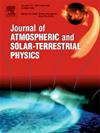Dayside dynamics of Alfvén waves during geomagnetic storms, including the initial phase
IF 1.8
4区 地球科学
Q3 GEOCHEMISTRY & GEOPHYSICS
Journal of Atmospheric and Solar-Terrestrial Physics
Pub Date : 2025-03-18
DOI:10.1016/j.jastp.2025.106493
引用次数: 0
Abstract
In this study, we investigated the dynamics of Alfvén waves as a global phenomenon in the solar wind-magnetosphere coupling as it occurs at the entry point to the dayside auroral acceleration region. It was found that total Alfvén wave power over the dayside auroral zone increases from 1.3 to 5.5 GW with increasing -Dst value, or alternatively, from minor, to moderate, and to major storm. As the storm intensity increases, the Alfvénic “band” (Alfvénic oval) expands to lower latitude with a peak at 76° invariant latitude (ILT) during the initial phase and a peak at 72° ILT during the storm phase of moderate to strong storms. In comparison with the nightside Alfvénic activity, the most striking result was that during the initial phase, enhanced Alfvén wave power mostly occurred on the dayside, which is in contrast to the storm phase which shows strong enhancement on both dayside and nightside. The different sources of initial phase and storm phase suggest different underlying Alfvén wave generation mechanisms in the dayside. Furthermore, similarity in distribution to the dayside storm aurora during the initial phase suggests contributions of Alfvénic auroral acceleration.
地磁暴期间alfvsamn波的日侧动力学,包括初始阶段
在这项研究中,我们研究了作为太阳风-磁层耦合的全球现象的alfvsamn波的动力学,因为它发生在日侧极光加速区的入口点。结果表明,随着-Dst值的增加,日侧极光带的总alfv波浪能从1.3 GW增加到5.5 GW,或由小风暴增加到中风暴,再增加到大风暴。随着风暴强度的增加,alfv录影带带(alfv录影带带椭圆)向低纬度扩展,初始阶段在76°不变纬(ILT)处达到峰值,中至强风暴阶段在72°不变纬处达到峰值。与夜侧alfv诈骗案活动相比,最显著的结果是在初始阶段,alfv诈骗案波能增强主要发生在日侧,而风暴阶段则在日侧和夜侧都表现出较强的增强。初始阶段和风暴阶段的不同来源表明日侧alfvsamn波的形成机制不同。此外,在初始阶段与日侧风暴极光的分布相似,表明阿尔夫萨奇型极光加速的贡献。
本文章由计算机程序翻译,如有差异,请以英文原文为准。
求助全文
约1分钟内获得全文
求助全文
来源期刊

Journal of Atmospheric and Solar-Terrestrial Physics
地学-地球化学与地球物理
CiteScore
4.10
自引率
5.30%
发文量
95
审稿时长
6 months
期刊介绍:
The Journal of Atmospheric and Solar-Terrestrial Physics (JASTP) is an international journal concerned with the inter-disciplinary science of the Earth''s atmospheric and space environment, especially the highly varied and highly variable physical phenomena that occur in this natural laboratory and the processes that couple them.
The journal covers the physical processes operating in the troposphere, stratosphere, mesosphere, thermosphere, ionosphere, magnetosphere, the Sun, interplanetary medium, and heliosphere. Phenomena occurring in other "spheres", solar influences on climate, and supporting laboratory measurements are also considered. The journal deals especially with the coupling between the different regions.
Solar flares, coronal mass ejections, and other energetic events on the Sun create interesting and important perturbations in the near-Earth space environment. The physics of such "space weather" is central to the Journal of Atmospheric and Solar-Terrestrial Physics and the journal welcomes papers that lead in the direction of a predictive understanding of the coupled system. Regarding the upper atmosphere, the subjects of aeronomy, geomagnetism and geoelectricity, auroral phenomena, radio wave propagation, and plasma instabilities, are examples within the broad field of solar-terrestrial physics which emphasise the energy exchange between the solar wind, the magnetospheric and ionospheric plasmas, and the neutral gas. In the lower atmosphere, topics covered range from mesoscale to global scale dynamics, to atmospheric electricity, lightning and its effects, and to anthropogenic changes.
 求助内容:
求助内容: 应助结果提醒方式:
应助结果提醒方式:


